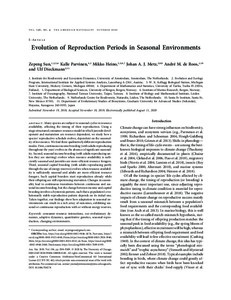Evolution of Reproduction Periods in Seasonal Environments
Johan A. J. Metz; Ulf Dieckmann; Zepeng Sun; Mikko Heino; André M. de Roos; Kalle Parvinen
Evolution of Reproduction Periods in Seasonal Environments
Johan A. J. Metz
Ulf Dieckmann
Zepeng Sun
Mikko Heino
André M. de Roos
Kalle Parvinen
UNIV CHICAGO PRESS
Julkaisun pysyvä osoite on:
https://urn.fi/URN:NBN:fi-fe2021042822575
https://urn.fi/URN:NBN:fi-fe2021042822575
Tiivistelmä
Many species are subject to seasonal cycles in resource availability, affecting the timing of their reproduction. Using a stage-structured consumer-resource model in which juvenile development and maturation are resource dependent, we study how a species' reproductive schedule evolves, dependent on the seasonality of its resource. We find three qualitatively different reproduction modes. First, continuous income breeding (with adults reproducing throughout the year) evolves in the absence of significant seasonality. Second, seasonal income breeding (with adults reproducing unless they are starving) evolves when resource availability is sufficiently seasonal and juveniles are more efficient resource foragers. Third, seasonal capital breeding (with adults reproducing partly through the use of energy reserves) evolves when resource availability is sufficiently seasonal and adults are more efficient resource foragers. Such capital breeders start reproduction already while their offspring are still experiencing starvation. Changes in seasonality lead to continuous transitions between continuous and seasonal income breeding, but the change between income and capital breeding involves a hysteresis pattern, such that a population's evolutionarily stable reproduction pattern depends on its initial one. Taken together, our findings show how adaptation to seasonal environments can result in a rich array of outcomes, exhibiting seasonal or continuous reproduction with or without energy reserves.
Kokoelmat
- Rinnakkaistallenteet [19204]
